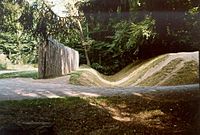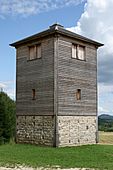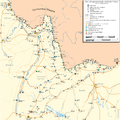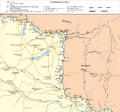Frontiers of the Roman Empire facts for kids
The Frontiers of the Roman Empire are a special World Heritage Site. This site shows us the old borders of the mighty Roman Empire. These borders were often protected by walls and forts.
The World Heritage Site includes three famous walls found in different parts of Europe:
- Hadrian's Wall in Britain
- Antonine Wall also in Britain
- The Limes Germanicus in Germany
These walls helped the Romans control their land and keep out invaders.
Contents
What is a Limes?
A Limes (pronounced "LEE-mess") is a Latin word. It means a border or a frontier. The Romans used this word to describe the walls, paths, and rivers that marked the edge of their empire. It wasn't just a line on a map. It was a whole system of defenses.
The Roman Empire was huge, and it needed strong borders to protect its lands. The Limes were built to:
- Stop enemies from invading
- Control who came in and out of the empire
- Collect taxes on goods
- Show the power of Rome
Famous Roman Walls
The three main parts of the Frontiers of the Roman Empire World Heritage Site are great examples of these borders.
Hadrian's Wall
Hadrian's Wall is in northern England. It was built by the Roman Emperor Hadrian starting in 122 AD. This wall stretched for about 117 kilometres (73 miles) from coast to coast.
It was made of stone and had many forts, watchtowers, and small forts called milecastles along its length. Roman soldiers lived and worked here, guarding the border.
Antonine Wall
The Antonine Wall is in Scotland. It was built later than Hadrian's Wall, around 142 AD, by Emperor Antoninus Pius. This wall was made mostly of turf (earth and grass) and was about 60 kilometres (37 miles) long.
It was built further north than Hadrian's Wall. The Romans tried to expand their empire into Scotland, but they didn't stay there for long. They eventually went back to Hadrian's Wall as their main border.
Limes Germanicus
The Limes Germanicus was a long frontier system in Germany. It was built to protect the Roman provinces of Upper Germania and Raetia. This Limes was very long, stretching over 550 kilometres (340 miles).
It wasn't always a single wall. In some parts, it was a wooden palisade (a fence of strong posts). In other parts, it was an earthen rampart (a bank of earth) with a ditch. There were also many forts and watchtowers along its route.
Life on the Limes
Life for Roman soldiers on the Limes was tough. They were far from home and had to be constantly ready for attacks. They built and maintained the walls, patrolled the borders, and kept watch for any trouble.
These frontiers were not just military lines. They were also places where people traded goods and where different cultures met. The Limes helped shape the history of Europe for hundreds of years.
Gallery
Images for kids
-
Map of fortifications and castles in North Britain around 155 AD (most forts on and south of Hadrian's Wall have been omitted).
-
Limes Africanus under Septimius Severus (The frontier of Roman Africa (dark tan) in the late 2nd century AD: Septimius Severus expanded the Limes Tripolitanus dramatically (medium tan), even briefly holding a military presence (light tan) in the Garamantian capital Garama in 203)
See also
 In Spanish: Limes para niños
In Spanish: Limes para niños
















